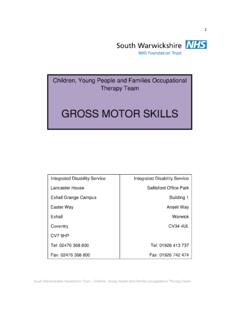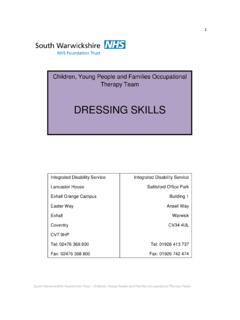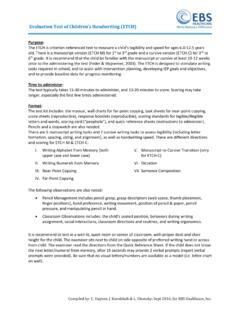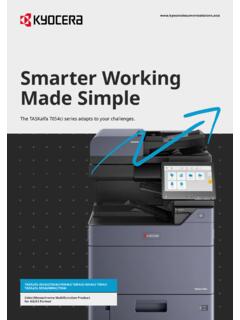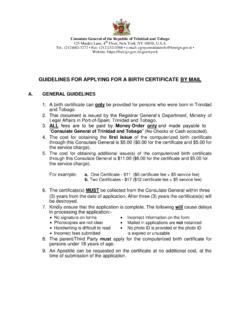Transcription of 6: Handwriting fluency and legibility - swft.nhs.uk
1 Occupational Therapy: Children, Young People & Families Department 6: Handwriting fluency and legibility Intervention Programme for Schools Mason Joanne (RJC) Occupational Therapist Swark-FT. Handwriting fluency Mar 2016. Intervention programme 6: Handwriting fluency AND. legibility . Aims: To develop Handwriting fluency and legibility Functional outcomes: Being able to complete legible written work within an appropriate length of time. Introduction This programme has been designed to improve Handwriting speed and legibility . If letter formation and neatness are problematic, please complete programme 5: Handwriting Letter Formation before starting this programme.
2 It is important to work on the letter formation and placement first, otherwise speeding up the Handwriting will cause the legibility to deteriorate further. You can use a commercially-available programme, such as Speed Up! instead of, or as well as, this Handwriting programme. Some of the later exercises in Write from the Start (Booklet 2) are also appropriate for this level. Handwriting speed may be influenced by: Delays in information processing Problems with spelling Motor co-ordination difficulties Labour-intensive style, which results from lack of tuition in Handwriting skills. Some children will always write slower than others, not because they cannot physically write faster, but because of the time it takes them to process information.
3 Other children need frequent breaks due to pain or fatigue in their hands, often because of a tight grip or heavy pressure. In some cases, the use of IT (typing or voice dictation software) will be the most appropriate means of recording written work. Quick or neat? We write at different speeds and with different attention to neatness depending on the circumstances. A quick shopping list or telephone message will be scribbled down faster (and less neatly) than a birthday card message. When writing in an exam, our aim is to get as much information down, legibly but not neatly, in the time available.
4 Handwriting fluency Mar 2016. Average words per minute by year group Year 7 Year 8 Year 9 Year 10 Year 11 Some general suggestions - Handwriting model: It is helpful to have a Handwriting model when teaching children to write, so they can learn consistent letter formations. - Once they are at the stage where speed becomes more important, a more pragmatic approach may be needed. Prioritise sizing and placement of letters and focus less on how close the child's letters are to a model alphabet (for example, some children seem to really struggle with continuous cursive and may be more efficient writers using a printed or italic script).
5 As children get older, they will develop more of a personal Handwriting style. Before you start . - Complete the Which Programme? Fine Motor Skills screening form to make sure you are choosing the appropriate programme for the child - Fill in the Baseline Assessment (see back of booklet) to get an idea of how the child is performing now. - Review the child's pencil grip. Is it functional? Is it comfortable? Do they fatigue or experience pain when writing? Give them the opportunity to experiment with different writing tools and pen grips. - Have they mastered letter formation? Speeding up poor letter formation is going to result in a deterioration in legibility .
6 If letter formation is still a problem, go back to Booklet 5 and complete this before working on fluency . Remember . - To fill in the Session Completion list (see back of booklet) to keep track of which sessions the child has completed. - To re-do the Baseline Assessment at the end to see how much progress the child has made. Further information You can find more information and resources on our website: Handwriting fluency Mar 2016. Overview Week 1 Warm up Main activities Session 1: Arm wake-up Handwriting assessment Pencil aerobics Choose your weapon Session 2: Bandage grab Feel the pressure Handwriting patterns to music Tip to tail Session 3: Rubber band stretch Alphabet write Doodle loops Letter lists Week 2 Warm up Main activities Session 1: Arm wake-up Alphabet write Pencil aerobics Dictation Session 2: Bandage grab Near-point copy Handwriting patterns to music Eyes shut patterns Session 3: Doodle loops Far-point copy Heavy/light Feel the pressure Week 3 Warm up Main activities Session 1.
7 Arm wake-up Dictation Pencil aerobics Eyes shut writing Session 2: Bandage grab Free-writing Handwriting patterns to music Session 3: Heavy/light Near-point copy Doodle loops Eyes-shut writing Week 4 Warm up Main activities Session 1: Arm wake-up Far-point copy Pencil aerobics Eyes shut writing Session 2: Bandage grab Free-writing Handwriting patterns to music Session 3: Rubber band stretch Dictation Doodle loops Feel the pressure Week 5 Warm up Main activities Session 1: Arm wake-up Near-point copy Pencil aerobics Eyes-shut patterns Session 2: Bandage grab Far-point copy Handwriting patterns to music Eyes shut writing Session 3: Feel the pressure Free-writing Doodle loops Carbon paper Week 6 Warm up Main activities Session 1: Arm wake-up Alphabet write Pencil aerobics Letter lists Session 2: Bandage grab Write a letter Handwriting patterns to music Session 3: Doodle loops Handwriting assessment Handwriting fluency Mar 2016.
8 Week 1: Session 1. Resources: Stopwatch Copy of the Handwriting assessment (see back of this booklet) for each pupil Sheets of the normal Handwriting paper used in class for each pupil Selection of pens, pencils, pen grips Warm-up: Arm wake-ups Shrug your shoulders to your ears then back down. Touch the sky, keeping your shoulders down. Touch your shoulders hand to same shoulder Touch your shoulders hand to opposite shoulder Push down on the desk Hold your hands out, palm up, then palm down Push palms together Pull hands apart Link your hands together and circle your wrists, one way then the other Make a fist, thumbs up and give them a wiggle Touch each finger to your thumb, one at a time, making a big circle.
9 Shake your hands out you're ready to begin! Pencil aerobics Hold onto the pencil as if you were going to write using your fingers only, walk up the pencil! And when you get to the end walk back down. Try this 5. times. Put your pencil down facing right, pick it up and be ready to write. Put your pencil down facing left, pick it up and be ready to write. Don't forget, only use one hand try this 3 times each side. Place your palm facing up with your pencil on it. Roll your pencil from your palm into your fingertips 10 times using movement of your fingers and wrist only. Pick up the pencil so you're ready to write.
10 Draw a dot on the paper. Now, using just that hand, turn the pencil round and rub out the dot. Repeat five times. Handwriting fluency Mar 2016. Main activities: Timed Handwriting assessment Carry out the Handwriting assessment, following the instructions at the back of this booklet. Choose your weapon! Set out a selection of pens and pencils, for example: gel pens, felt tips, biros, pens with thicker barrels, ergonomic pens (like the Stabilo pen), soft and hard pencils, mechanical pencils, fountain pens, italic pens. Add as many different types of pencil grip as you can find. Encourage the children to try all the different pens and grips and ask them to think about: What do they feel like to hold?
